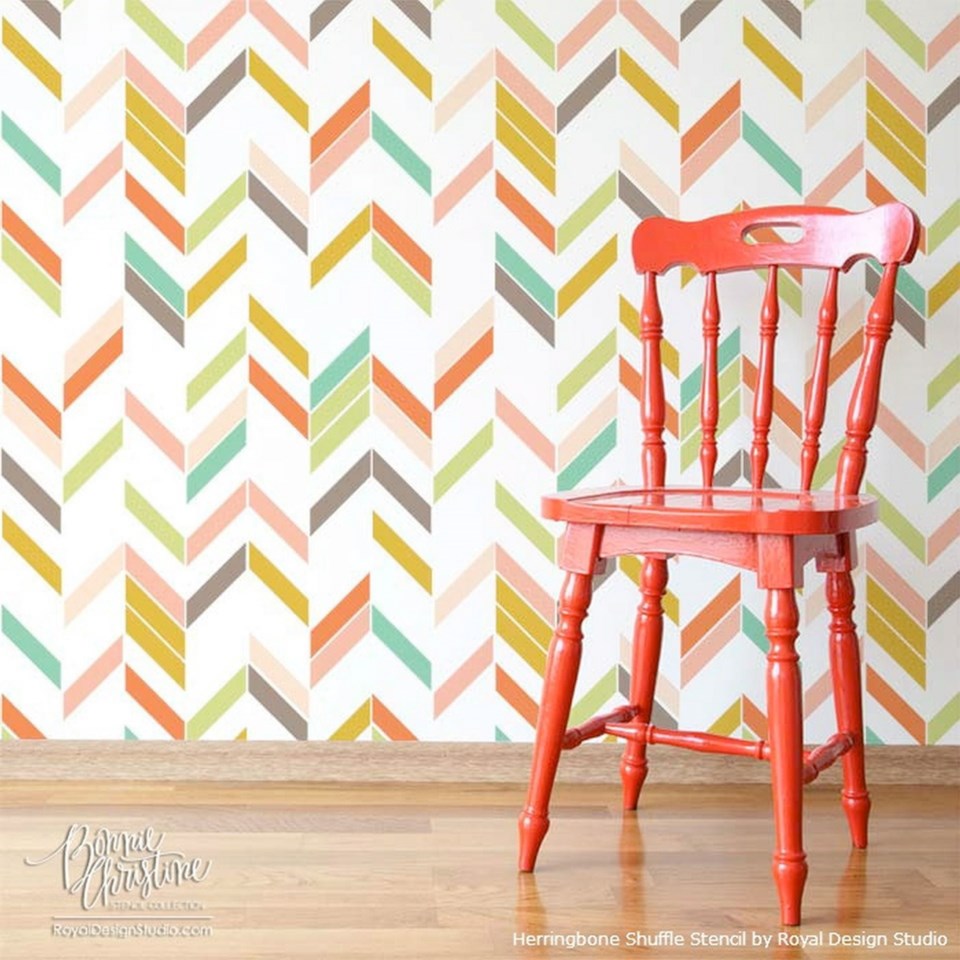Are you looking for a simple trick to update your rooms and add a personal touch? Take a standard pattern or colourway and tweak it. That might sound odd, but hear me out.
I came across a photo of a cheeky wall decoration where a particular style takes a few whimsical steps out of the norm. The vivid pattern on the wall shown here is commonly known as herringbone, which in its more subdued state is among the traditional favourites for flooring.
Standard rectangular tiles are set up against each other, meeting at a perfect straight edge to form a zigzag line. The pattern can cover the entire floor or simply sit around the edges as a handsome detail.
Shades of wood and various wood grains make intriguing patterns. But back to that cheeky wall and how it plays with the herringbone pattern.
The wall has been stenciled using Herringbone Shuffle from royaldesignstudio.com. Shifting around colours and leaving spaces blank as you move the stencil along is just what the pattern needs to give it a quirky modern edge.
No two people would choose the same colours to apply this treatment; your wall would be a truly original work of art. It’s perhaps a bit overwhelming for a whole room but exciting as a feature wall.
It would also suit a line of kitchen cabinet doors, a teen’s chest of drawers or a play tabletop. There are so many ways to recreate this pattern.
The herringbone pattern hails back to ancient times. This stone-paving design made extremely durable roads and thoroughfares during the Roman Empire. I have laid a herringbone pattern made from narrow bricks in my courtyard in Tuscany. Its practical design has endured and appears in other building materials.
The many options include wood tiles, porcelain tiles, bricks, stones or a mix of materials. Laid in a monotone colourway, herringbone creates interest but does not overpower a room.
In the bathroom seen here by RENOVA, white grouting softly emphasizes the blue shower wall tiles so that the pattern is distinct.
The adjacent walls and floor have patterns and mosaics that blend into a calm oasis of shades and shapes.
If you decide to apply this pattern to a floor or wall, the building blocks must be placed perfectly.
As with any geometric design, if the lines don’t sit precisely, the overall pattern will become skewed.
This becomes particularly difficult on a surface that isn’t even. There is much measuring and levelling and you may wish to hire a professional.
As a background pattern, herringbone adds excitement to otherwise plain decor. What a great idea as a backdrop for a soft cushiony headboard.
This chic bedroom is inspiration from Yoo2 hotel, easily transferrable to your home. Utilize herringbone and chevron fabrics for pillows and cushions — a big floor cushion looks perfect in a modern den.
Introduce the look in other ways, such as window blinds or bed linens. You have a full range of products from which to choose the look that makes your style buzz.
Think about a fresh way to incorporate one or more standard motifs into your personal design portfolio (yes, you do have one).
For vertical surfaces, set squares on their points running across the wall at chair rail height. Devise circles inside each other alternating colours and dangling from string.
Geometrics are always fun to play with and so are exaggerated dimensions. Blow up florals and leaves, a very on-trend style that is made for nature lovers.
Mix patterns around a border. Insert a surprise colour in an otherwise simple interior. It’s time for you to be cheeky.
Written by Debbie Travis and Barbara Dingle. Please email decorating questions to [email protected]. Follow Debbie at instagram.com/debbie_travis, facebook.com/thedebbietravis, debbietravis.com



